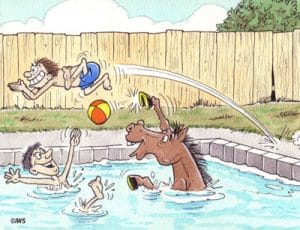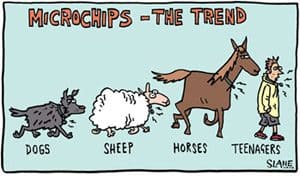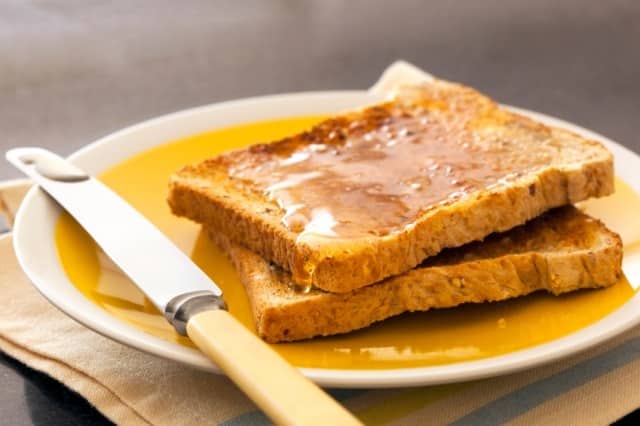
Remember this?
In late November, in San Antonio, Texas, I had a busy meeting at the American Association of Equine Practitioners (AAEP) meeting. San Antonio is a great town, and there’s lots to see, but, of course, the reason for going is the annual convention, where many (many) papers are presented about a variety of horse-related topics. I thought it might be fun to summarize some of the more important and relevant papers in an effort to keep you up on breaking new in the horse world.
BRIEF ASIDE: There are a good number of rather esoteric papers that might be of interest if you’re either in specialty practice or if you happen to be one of the few unfortunate people who has a horse with the rare condition described. I’m not in the former but I’ll be ready to help the latter, even though I hope I never see one of those rare cases (they can be really tough).
This will be a good review for me, I think There’s enough information to populate a few articles, too. Here goes.
 WATER TREADMILLS
WATER TREADMILLS
Investigators in Canada and Washington concluded that if you exercise a horse on a water treadmill, it will significantly improve their maximum oxygen consumption. As someone who is interested in horse physiology, I found that pretty interesting. Oxygen consumption should be correlated to endurance. Up to now, it’s pretty much been assumed that horses can’t change the ventilation of their lungs. Plus, when they run flat out, they breathe with each stride, and that can’t be changed either. Still, based on this investigation, it appears to running in water can help horse get more oxygen out of each breath.
DR. RAMEY NOTES: While this is interesting if you’re into horse physiology, the practical implications are a bit less clear. I guess if you have a water treadmill, it can give you some optimism for improving your horse’s endurance, although if you’re a trail rider (or many other disciplines) those findings aren’t of much practical value: a good number of horse events don’t really tax a horse’s endurance anyway. Still, if you’re looking to fill up some space in your paddock or barn, and especially if you like aqua sports for your horse, at least you’ll have a rationale.
MANUKA HONEY AND WOUNDS
 Honey has received some acclaim as an agent which you can put onto wounds. There’s some good rationale for its use: I even wrote an article about it. As with most anything else in medicine, there’s always curiosity if one treatment is better than another, so, in that regard, researchers from Australia looked to see if Manuka honey was better than treating wounds than was plain old regular honey. Manuka honey, if you didn’t know, is produced from the nectar of the manuka tree, which is native to Australia and New Zealand. This, of course, makes it particularly appealing to those who believe that the best things always come from somewhere else (unless you’re in New Zealand or Australia, in this instance).
Honey has received some acclaim as an agent which you can put onto wounds. There’s some good rationale for its use: I even wrote an article about it. As with most anything else in medicine, there’s always curiosity if one treatment is better than another, so, in that regard, researchers from Australia looked to see if Manuka honey was better than treating wounds than was plain old regular honey. Manuka honey, if you didn’t know, is produced from the nectar of the manuka tree, which is native to Australia and New Zealand. This, of course, makes it particularly appealing to those who believe that the best things always come from somewhere else (unless you’re in New Zealand or Australia, in this instance).
Anyway, the investigators made wounds on horse legs and treated them with manuka honey, as well as a much-less-exotic alternative. They concluded that the manuka honey-treated wounds healed faster than plain old honey-treated wounds: 90 days vs. 100 days.
DR. RAMEY NOTES: I’m not really overwhelmed by this paper, mostly because at every other measured time point, except at day 42, there weren’t any differences in the wounds. Plus, even if you were to go about cutting  inch squares into your horse’s legs (the experimental model), I’m not sure that it’s worth paying a bunch more money (manuka honey is expensive) to get some honey laboriously produced by Kiwi bees in order to get a wound to heal 10 days faster – and frankly, I’m king of surprised that it took 100 days for such a small wound to heal. Studies like this bring up the question of clinical relevance: sure there may be a slight difference, but is it really enough difference to make a difference?. Interesting paper, but with the other great uses that honey has (e.g., on toast), I’ll probably just keep domestic bees in business.
inch squares into your horse’s legs (the experimental model), I’m not sure that it’s worth paying a bunch more money (manuka honey is expensive) to get some honey laboriously produced by Kiwi bees in order to get a wound to heal 10 days faster – and frankly, I’m king of surprised that it took 100 days for such a small wound to heal. Studies like this bring up the question of clinical relevance: sure there may be a slight difference, but is it really enough difference to make a difference?. Interesting paper, but with the other great uses that honey has (e.g., on toast), I’ll probably just keep domestic bees in business.
ARE A MARE’S BEHAVIOR PROBLEMS RELATED TO HER OVARIES?
 As appears to be the case for the females of many species, I think that mare’s quite often get unfairly criticized for having ovaries. If a mare looks left when her rider wanted to go right, lifts her tail, seems annoyed at a particularly threatening bit of plastic, or demonstrates just about ANY behavior that annoys her owner, the ovaries are usually the direction in which the finger of blame gets pointed.
As appears to be the case for the females of many species, I think that mare’s quite often get unfairly criticized for having ovaries. If a mare looks left when her rider wanted to go right, lifts her tail, seems annoyed at a particularly threatening bit of plastic, or demonstrates just about ANY behavior that annoys her owner, the ovaries are usually the direction in which the finger of blame gets pointed.
Noted equine behaviorist Dr. Sue McDonnell, of the University of Pennsylvania, presented an interesting paper showing that behavior problems most often have causes other than those related to standard mare equipment. That is, if a mare is showing perplexing behavioral signs and/or physical pain, more often than not, the problem is NOT related to the ovaries.
DR. RAMEY NOTES: Trying to figure these cases out is not easy. They require extended periods of observation and, often, some pretty advanced and involved diagnostic techniques. At the end of the day, some of the problems can’t be helped much, either. But I think it’s really important for horse owners to realize that you can’t solve all behavioral problems of a female horse by squirting some hormones in her mouth, giving her a shot, or even taking out her ovaries. There’s often a lot more lurking under the surface.
THE PROBLEMS WITH MICROCHIPS
 Microchips are all the rage for horse identification, and they are now required for horses in USEF jumping competitions and for FEI horses. This is all well and good, of course, and it’s a way that horses can be identified to keep competitors from doing things like switching horses without telling anybody (gasp!).
Microchips are all the rage for horse identification, and they are now required for horses in USEF jumping competitions and for FEI horses. This is all well and good, of course, and it’s a way that horses can be identified to keep competitors from doing things like switching horses without telling anybody (gasp!).
The problem is that just having a microchip in a horse doesn’t necessarily solve anything, when it comes to tracing horses. It’s apparently one thing to put a chip into a horse – it’s another thing entirely to keep records of having done it: records that follow the horse. So, for example, if a horse gets sold, and the microchip doesn’t get transferred, there’s a permanent dead-end, insofar as trying to identify the horse. It would help if breed registries or competition organizations would keep that information, but, so far, they don’t. Chip manufacturers might, at least initially, but the chip has to be registered there, too, and, turns out that not all chip manufacturers are keeping up with requirements, either. What’s lacking is a backup tool that’s accessible by the public. This is something that’s being discussed, but we’re not there yet.
 DR. RAMEY NOTES: If you get your horse microchipped, register it with the company and keep the contact number of the company in your files. If you sell your horse, make sure that information goes with the horse. Currently, that’s about the best that you can do.
DR. RAMEY NOTES: If you get your horse microchipped, register it with the company and keep the contact number of the company in your files. If you sell your horse, make sure that information goes with the horse. Currently, that’s about the best that you can do.
There’s a start. I’ll be going through the AAEP Proceedings and doing a few more article summaries in the upcoming weeks. There’s always something to learn in the horse world!







